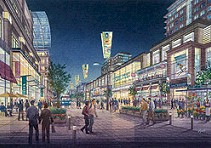|
|
VIVA
Downtown Markham!
Suburban
Toronto's New Markham project, a mixed use
community served by Bus Rapid Transit, could serve
as a new model for development in Northern
Virginia.
Last
May, a new project broke ground in suburban
Toronto that ought to change the way we think
about growth in Northern Virginia. The 243-acre,
transit- oriented site known as Downtown Markham
will include 4,000 new condominiums and townhouses
and more than 4.2 million square feet of office
space. According to the developer, Downtown
Markham will be the largest mixed-use development
in North America.
Inspired
by Europe's mixed-use communities, the project was
developed with a “vision of promoting
sustainability, encouraging car-free,
pedestrian-friendly urban living not previously
seen in any North American suburb.” Investment
will total at least $3 billion and residences are
being marketed as “luxury” units, with
townhouses starting at over $630,000.
|

Leslie
Street looking south toward intersection
with Highway 7, Richmond Hill, York Region,
Ontario, Canada. |
Downtown
Markham is a radical step forward in the
development of suburban Toronto. It is
located in the York Region, a northern
suburb marked by car-oriented office parks
and strip malls. As shown in the photo,
existing roads are wide and pedestrian
connections are poor or non-existent, in
many ways similar to Northern Virginia. York's |
population, roughly one million, grew at a rate of
more than 50,000 per year between 2001 and 2006.
| Downtown
Markham offers a more livable approach. The
center piece will be Simcoe Promenade, a
“grand allée” lined with shops,
restaurants, offices, and residences
accessible only to pedestrians and public
transit. The VIVA bus rapid transit system
will link Downtown Markham |

Rendering
of Simcoe Promenade (currently under
construction),
Downtown
Markham. |
to the rest of Greater Toronto, giving residents
and visitors the opportunity to leave their cars
at home.
|

Richmond
Hill Centre transit station, VIVA BRT, York
Region
|
Planning
for Phase I of VIVA began in 2001 and the
project opened just four years later. VIVA
currently has five lines that provide
extensive service throughout the York Region
as well as multiple connections to the
Toronto subway. There are over 90 custom
shelters and stations, traffic signal
priority, and fare collection and |
real-time
vehicle-arrival signs in the stations. The capital
costs for VIVA Phase I were $150 million. Phase II
construction will begin next year and includes
adding dedicated transit lanes, such as the
segment on Simcoe Promenade.
As
demonstrated by the $3 billion investment in
Downtown Markham, developers are embracing
BRT in suburban Toronto. Indeed, as shown in
the photo, the developer of Downtown Markham
is using images of VIVA in its marketing
material. Extensive references to VIVA also
are made on the developer’s website.
The
combination of VIVA and Downtown Markham
provides a compelling vision for Northern
Virginia. In just a few years, we could have
a network of suburban
|

Marketing
Brochure for "The Verdale Luxury Condo-
miniums of Downtown Markham," The
Remington Group, Inc. |
rapid
transit services that would link major activity
centers, connect with existing services like
Metrorail and Virginia Railway Express, and
provide many new opportunities for
transit-oriented development. Over time, the
system could be upgraded and expanded, or
converted to rail, if desired. Indeed, the current
long-term vision for VIVA is to convert to rail.
This
approach has many advantages over the lengthy,
costly and high-risk extension of Metrorail along
the Dulles Corridor. Intensive planning and
engineering for Dulles Rail began at least 12
years ago, and estimated costs have increased by
more than threefold to over $5 billion. Meanwhile,
Northern Virginia continues to sprawl without the
benefit of new rapid transit services.
|

Rendering
of Tysons Central 7 Station, Dulles
Metro extension |
A
phased, VIVA-like approach could have new
transit services operating throughout
Northern Virginia in just a few years and
for a reasonable budget, with upgrades and
possible conversions implemented over time.
|
A
phased approach also could avoid many of the
compromises brought about by the enormous cost of
rail, such as the elevation of the rail line in
the middle of a widened Route 7 running through
Tysons Corner. Rail stations will be surrounded by
four lanes of traffic, severely limiting
pedestrian access and making pedestrian-friendly
design, like Downtown Markham, difficult to
achieve.
|
Arguably, the planning for rail looks
even worse west of Tysons Corner: Rail stations
there will be stuck in the middle of the Dulles
Access road, surrounded by six lanes of traffic on
either side. Transit
oriented development next to the rail
stations will be impossible, and activity
centers like Reston Town Center and Herndon
will be well out of walking distance for
most passengers. |

Satellite
view of the Dulles Access/Toll Roads at
Reston Parkway
(Google
Earth) |
Regardless
of whether Dulles Rail moves forward, it
seems clear that we need a new vision for
managing growth in
Northern
Virginia. I think the Downtown Markham project
could provide an excellent model. Bus rapid transit
services can be directly integrated with
pedestrian facilities, instead of separated by
elevation and multiple lanes of traffic. Stations
can be located next to shops, restaurants, and
offices instead of isolated in a river of cars.
Finally,
the transit system itself can serve a significant
portion of the region, not just one corridor, and
can be operational in just a few years at a
reasonable cost.
--
October 1, 2007
|
